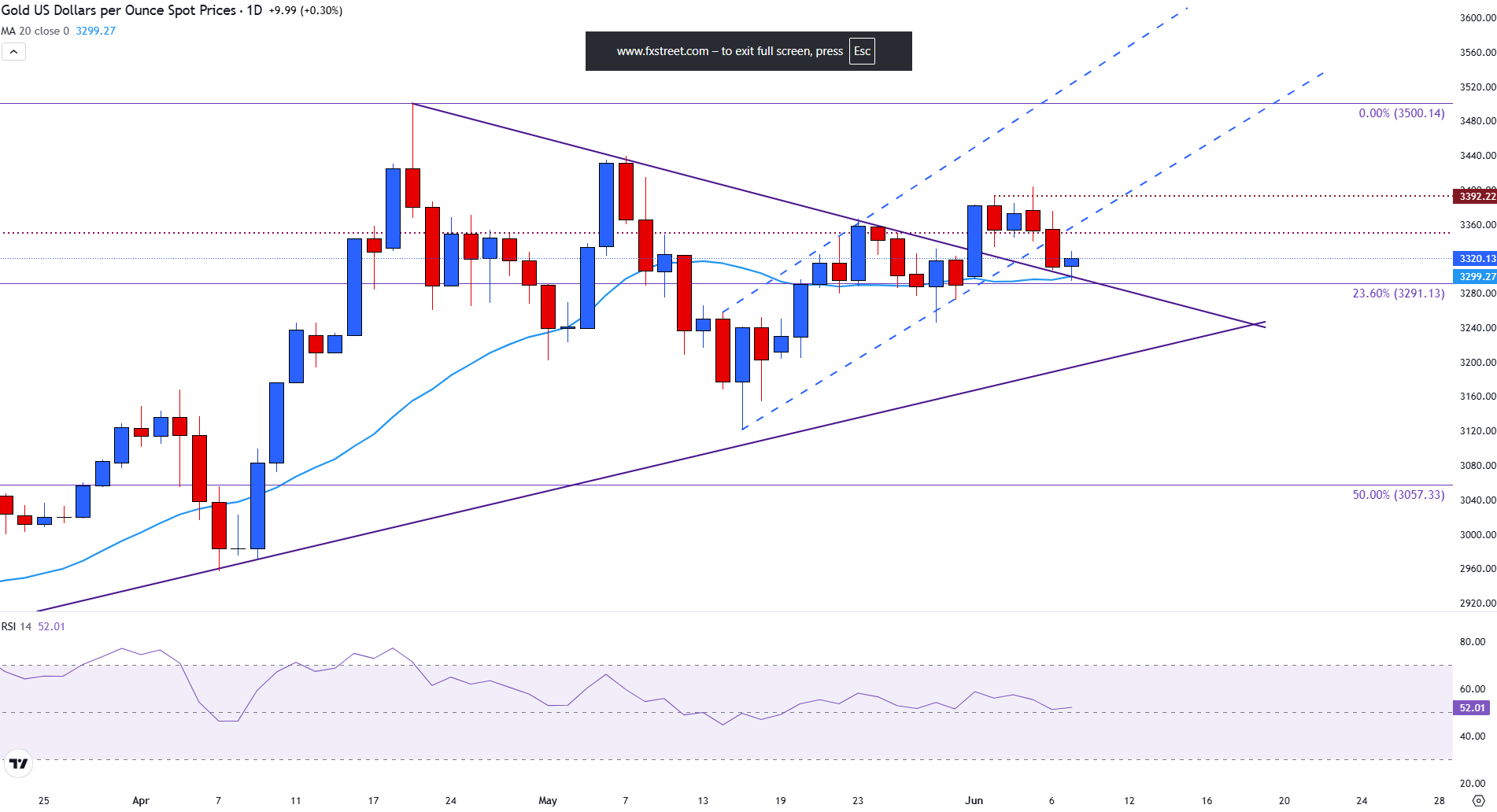Gold prices rise, stabilising above $3,300 ahead of US-China trade talks
- Gold prices find temporary support above $3,300 with triangle and Moving Average support at
- Gold and safe-havens wait for further confirmation ahead of US-Chinal trade talks in London
- Gold prices rise above $3,300 with resistance at $3,350.
Gold prices remained at an elevated level on Monday, despite the start of US-China trade talks in London. Alongside the United States’ (US) 50% tariffs on steel and aluminum imports, Gold has been supported by broader geopolitical tensions, such as the ongoing warfare between Ukraine and Russia over the weekend, which have reinforced Gold's safe-haven status.
Gold Daily Digest: Can US-China Talks Lift Safe-Haven Gold?
- Friday’s Nonfarm Payrolls (NFP) report came in better than expected, which has eased fears of the Federal Reserve (Fed) cutting rates in the short term.
- On Thursday, Reuters reported that the Canadian Prime Minister called US tariffs “illegal,” while Mexico and the European Union expressed similar frustration.
- On Wednesday, Mexican President Claudia Sheinbaum called the new tariffs "unjust, unsustainable, and without legal grounds," warning that if a deal is not reached, Mexico will be forced to respond with retaliatory measures.
- Canada and the EU have also threatened to retaliate if no progress is made in trade talks this week.
Gold prices remain under pressure on Monday, retreating from last week's highs as technical indicators suggest waning bullish momentum. After failing to hold above the $3,339–$3,392 resistance zone, prices broke below short-term support near $3,320 and are now testing the 23.6% Fibonacci retracement level at $3,291. This level has become a key pivot in the near term, with a daily close below it likely to attract fresh selling pressure.
The broader price action continues to consolidate within a symmetrical triangle, suggesting indecision among market participants. The lower boundary of this pattern is currently under threat, and a confirmed breakdown could expose the ascending trendline support around $3,250–$3,260. Below that, deeper losses could take prices toward the 50% Fibonacci retracement at $3,057, a level that aligns with previous structural support.
On the upside, any rebound must clear the $3,339–$3,392 region to reassert bullish control. A break above this zone would pave the way toward the $3,500 mark, which remains the medium-term target for Gold bulls. However, with the 20-day Simple Moving Average (SMA) turning flat near $3,299, upside momentum has clearly stalled.
Momentum indicators also reflect this indecision. The Relative Strength Index (RSI) is currently hovering around 52, indicating neutral sentiment with no immediate overbought or oversold conditions. This suggests that Gold may continue to consolidate unless triggered by a major fundamental catalyst, such as updates to US interest rates or further geopolitical developments.
Gold’s technical structure has weakened slightly following the breakdown below short-term support on Friday. A decisive close below $3,291 would likely shift the outlook to bearish in the near term, while holding above the triangle base could still offer a path back toward resistance.
Gold daily chart

US-China Trade War FAQs
Generally speaking, a trade war is an economic conflict between two or more countries due to extreme protectionism on one end. It implies the creation of trade barriers, such as tariffs, which result in counter-barriers, escalating import costs, and hence the cost of living.
An economic conflict between the United States (US) and China began early in 2018, when President Donald Trump set trade barriers on China, claiming unfair commercial practices and intellectual property theft from the Asian giant. China took retaliatory action, imposing tariffs on multiple US goods, such as automobiles and soybeans. Tensions escalated until the two countries signed the US-China Phase One trade deal in January 2020. The agreement required structural reforms and other changes to China’s economic and trade regime and pretended to restore stability and trust between the two nations. However, the Coronavirus pandemic took the focus out of the conflict. Yet, it is worth mentioning that President Joe Biden, who took office after Trump, kept tariffs in place and even added some additional levies.
The return of Donald Trump to the White House as the 47th US President has sparked a fresh wave of tensions between the two countries. During the 2024 election campaign, Trump pledged to impose 60% tariffs on China once he returned to office, which he did on January 20, 2025. With Trump back, the US-China trade war is meant to resume where it was left, with tit-for-tat policies affecting the global economic landscape amid disruptions in global supply chains, resulting in a reduction in spending, particularly investment, and directly feeding into the Consumer Price Index inflation.



